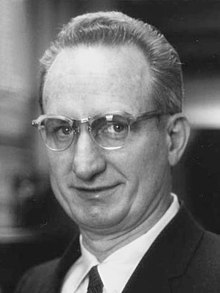
Back جيمس رينوتر Arabic جيمس رينوتر ARZ لئو جیمز رینواتر AZB Леа Джэймс Рэйнуотэр BE Джеймс Рейнуотър Bulgarian জেমস রেইনওয়াটার Bengali/Bangla James Rainwater Catalan James Rainwater Czech James Rainwater Danish James Rainwater German
Leo James Rainwater | |
|---|---|
 Rainwater in 1975 | |
| Born | December 9, 1917 Council, Idaho, U.S. |
| Died | May 31, 1986 (aged 68) New York City, U.S. |
| Education | California Institute of Technology (BA) Columbia University (MA, PhD) |
| Awards | Ernest Orlando Lawrence Award (1963) Nobel Prize in Physics (1975) |
| Scientific career | |
| Institutions | Columbia University Manhattan Project |
| Thesis | Neutron beam spectrometer studies of boron, cadmium, and the energy distribution from paraffin (1946) |
| Doctoral advisor | John R. Dunning |
Leo James Rainwater (December 9, 1917 – May 31, 1986) was an American physicist who shared the Nobel Prize in Physics in 1975 for his part in determining the asymmetrical shapes of certain atomic nuclei.
During World War II, he worked on the Manhattan Project that developed the first atomic bombs. In 1949, he began developing his theory that, contrary to what was then believed, not all atomic nuclei are spherical. His ideas were later tested and confirmed by Aage Bohr's and Ben Mottelson's experiments. He also contributed to the scientific understanding of X-rays and participated in the United States Atomic Energy Commission and naval research projects.
Rainwater joined the physics faculty at Columbia in 1946, where he reached the rank of full professor in 1952 and was named Pupin Professor of Physics in 1982. He received the Ernest Orlando Lawrence Award for Physics in 1963 and in 1975 was awarded the Nobel Prize in Physics, "for the discovery of the connection between collective motion and particle motion in atomic nuclei and the development of the theory of the structure of the atomic nucleus based on this connection".[1]
- ^ "The Nobel Prize in Physics 1975". Nobel Foundation. Retrieved January 16, 2014.